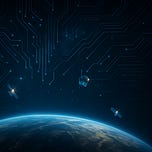Before Sputnik blinked into orbit in 1957, the night sky was thought to be unspoiled — a blank slate upon which humanity would soon etch its ambitions. But recent findings suggest that the canvas was already crowded. Not with natural wanderers, but with silent sentinels glinting like mirrors — too reflective, too aligned, too aware of where Earth’s shadow falls.
In this edition of MyGeekSpace, I explore one of the most provocative scientific papers I’ve encountered in recent memory — and a question that should be echoing across astronomy, UAP research, and SETI circles alike:
Who built the satellite grid over Earth decades before we could?
The Astronomer Who Looked Backwards in Time
Dr Beatriz Villarroel, a cosmologist at NORDITA and principal investigator of the VASCO and EXOPROBE projects, did something few astronomers have dared in the AI-saturated present: she turned to the past. By digitising and reanalysing nearly 300,000 images from the 1950s First Palomar Sky Survey — a time capsule before human spaceflight — her team found glint-producing transients. Not meteors, not stars, and most certainly not photographic defects.
They were too aligned.
Too reflective.
And too statistically anomalous to ignore.
Evidence in the Glint: Signatures of Something Built
Using a robust methodology, Villarroel’s team identified multiple brief flashes — some forming tight, almost geometric alignments within a single 50-minute exposure. These weren't smudges or artefacts. They passed validation checks across different digitisation methods and survived careful inspection against known atmospheric and optical anomalies.
What makes the results so provocative?
Solar Reflection Geometry: The flashes behave like glints from flat, mirror-like surfaces — consistent with artificial panels or smooth construction, not natural objects.
Shadow Deficit: When Earth’s shadow swept over part of the sky, the flashes vanished — a statistically overwhelming absence (21.9σ significance). This rules out internal emulsion defects. Plate flaws don’t know when it’s night.
Aligned Patterns: These point-source flashes often appeared in narrow bands, statistically improbable unless something was intentionally constructed, perhaps spinning, tumbling, or precessing in geosynchronous orbit.
Temporal Coincidences: The most notable alignment, Candidate 5, occurred on the same night as the second wave of the 1952 Washington D.C. UFO flyovers — one of the most documented mass sightings in modern UAP history.
Surveillance in the Nuclear Age?
The implications ripple across disciplines.
Villarroel’s team found a 3σ-level correlation between these transients and major nuclear tests conducted by the U.S., U.K., and U.S.S.R. during the 1950s. The suggestion? These objects were watching us — or reacting to our thermonuclear experimentation.
It aligns with long-held hypotheses within the Disclosure movement: that certain UAP phenomena are monitoring humanity’s destructive capacities. Now we have a statistically significant pre-satellite dataset to support that idea, backed by empirical analysis rather than anecdote.
Technosignatures from the Deep Past?
While Dr Villarroel avoids the term "aliens," she does not dismiss the possibility that these are probes — potentially autonomous, ancient, or even artefacts from a forgotten human epoch. She entertains a bold thought: these objects might not be recent visitors, but long-term observers. Dormant. Invisible to the unaided eye. Waiting.
Could they be remnants of a previous cycle of advanced civilisation?
A distributed network of watchers?
Or an early warning system seeded by something else entirely?
Whatever their nature, they raise the spectre of the Techno-Terrestrial — my term for non-human technologies already entangled with Earth's evolutionary story.
Breaking the Taboo of the Skies
This work isn’t speculative mysticism. It's peer-anchored, anomaly-driven science that challenges our cosmological assumptions. And yet, Villarroel expects resistance. As she puts it:
“There’s so much stigma in the astronomy community… but the science backs it up.”
She’s right. The findings aren’t a fluke or optical illusion. The glints disappear in Earth’s shadow, appear in statistically rare alignments, and cluster around nuclear detonations and historical UAP events.
They defy explanation.
They demand attention.
A New Sky to Watch
The VASCO and EXOPROBE projects are now scanning today’s skies for similar phenomena. But something essential has changed: we are no longer looking into the void of space. We are peering into an archive — a ledger of encounters and traces hidden not in the future, but in the layers of light from our past.
This is not just about satellites.
It’s about memory.
And what might be remembering us.
Final Thought
Dr Villarroel’s quiet revolution invites us to reconsider the origin story of the satellite age. What if our leap into space was not the beginning of the grid, but a late arrival to something already in motion?
What if Homo sapiens is the newcomer?
The guest.
The observed.
Join the Conversation
🎙️ A podcast/audio version of this overview is now live on MyGeekSpace.
📺 Companion Video Interview:
“Exclusive: Astronomer's new data finds possible nonhuman intelligence in space”
In this episode of Reality Check, journalist Ross Coulthart interviews Dr Beatriz Villarroel about her groundbreaking study — currently under peer review — which may provide evidence of constructed technology in pre-satellite Earth orbit. If confirmed, it could mark a pivotal moment in the scientific recognition of UAPs.
Watch here:
📄 Original Research Paper:
“Aligned, multiple-transient events in the First Palomar Sky Survey” (Preprint, July 2025)
I invite you to read, listen, and reflect. Are we decoding the whispers of a long-forgotten satellite architecture? Could this be the first scientifically verifiable trace of non-human surveillance?
🛰️ Drop your thoughts in the comments.
📡 Share with those who still believe the sky is empty.
🌍 Follow my journey on Notes, LinkedIn and 𝕏 @frankdasilva for real-time insights and bold ideas, and explore my broader work at Frank Da Silva – Living the Future.
🔥 Summer Special – 25% Off for 12 Months!
Subscribe now and get full access to MyGeekSpace for a whole year at 25% off. The offer is valid all summer long for new subscribers. Let’s #LiveTheFuture together. If you’ve found value in this journey, please consider supporting MyGeekSpace as a paid subscriber.









